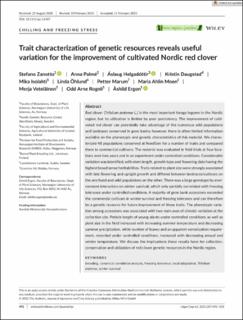| dc.contributor.author | Zanotto, Stefano | |
| dc.contributor.author | Palmé, Anna | |
| dc.contributor.author | Helgadóttir, Áslaug | |
| dc.contributor.author | Daugstad, Kristin | |
| dc.contributor.author | Isolahti, Mika | |
| dc.contributor.author | Öhlund, Linda | |
| dc.contributor.author | Marum, Petter | |
| dc.contributor.author | Moen, Maria Ahlin | |
| dc.contributor.author | Veteläinen, Merja | |
| dc.contributor.author | Rognli, Odd Arne | |
| dc.contributor.author | Ergon, Åshild | |
| dc.date.accessioned | 2021-10-20T09:02:51Z | |
| dc.date.available | 2021-10-20T09:02:51Z | |
| dc.date.created | 2021-07-01T09:28:16Z | |
| dc.date.issued | 2021-03-20 | |
| dc.identifier.citation | Journal of Agronomy and Crop Science. 2021, 207 (3), 492-503. | en_US |
| dc.identifier.issn | 0931-2250 | |
| dc.identifier.uri | https://hdl.handle.net/11250/2824038 | |
| dc.description.abstract | Red clover (Trifolium pratense L.) is the most important forage legume in the Nordic region, but its utilization is limited by poor persistency. The improvement of cultivated red clover can potentially take advantage of the numerous wild populations and landraces conserved in gene banks; however, there is often limited information available on the phenotypic and genetic characteristics of this material. We characterized 48 populations conserved at NordGen for a number of traits and compared them to commercial cultivars. The material was evaluated in field trials at four locations over two years and in an experiment under controlled conditions. Considerable variation was identified, with stem length, growth type and flowering date having the highest broad sense heritabilities. Traits related to plant size were strongly associated with late flowering and upright growth and differed between landraces/cultivars on the one hand and wild populations on the other. There was a large genotype by environment interaction on winter survival, which only partially correlated with freezing tolerance under controlled conditions. A majority of gene bank accessions exceeded the commercial cultivars in winter survival and freezing tolerance and can therefore be a genetic resource for future improvement of these traits. The phenotypic variation among accessions was associated with two main axes of climatic variation at the collection site. Petiole length of young plants under controlled conditions as well as plant size in the field increased with increasing summer temperature and decreasing summer precipitation, while number of leaves and an apparent vernalization requirement, recorded under controlled conditions, increased with decreasing annual and winter temperature. We discuss the implications these results have for collection, conservation and utilization of red clover genetic resources in the Nordic region. | en_US |
| dc.language.iso | eng | en_US |
| dc.publisher | John Wiley & Sons Ltd. | en_US |
| dc.rights | Attribution-NonCommercial-NoDerivatives 4.0 Internasjonal | * |
| dc.rights.uri | http://creativecommons.org/licenses/by-nc-nd/4.0/deed.no | * |
| dc.title | Trait characterization of genetic resources reveals useful variation for the improvement of cultivated Nordic red clover | en_US |
| dc.type | Peer reviewed | en_US |
| dc.type | Journal article | en_US |
| dc.description.version | publishedVersion | en_US |
| dc.rights.holder | © 2021 The Authors | en_US |
| dc.source.pagenumber | 492-503 | en_US |
| dc.source.volume | 207 | en_US |
| dc.source.journal | Journal of Agronomy and Crop Science | en_US |
| dc.source.issue | 3 | en_US |
| dc.identifier.doi | 10.1111/jac.12487 | |
| dc.identifier.cristin | 1919739 | |
| dc.relation.project | Nordisk ministerråd: Arctic Co-operation Programme | en_US |
| dc.relation.project | Andre: Nansenfondet | en_US |
| cristin.ispublished | true | |
| cristin.fulltext | original | |
| cristin.qualitycode | 1 | |

